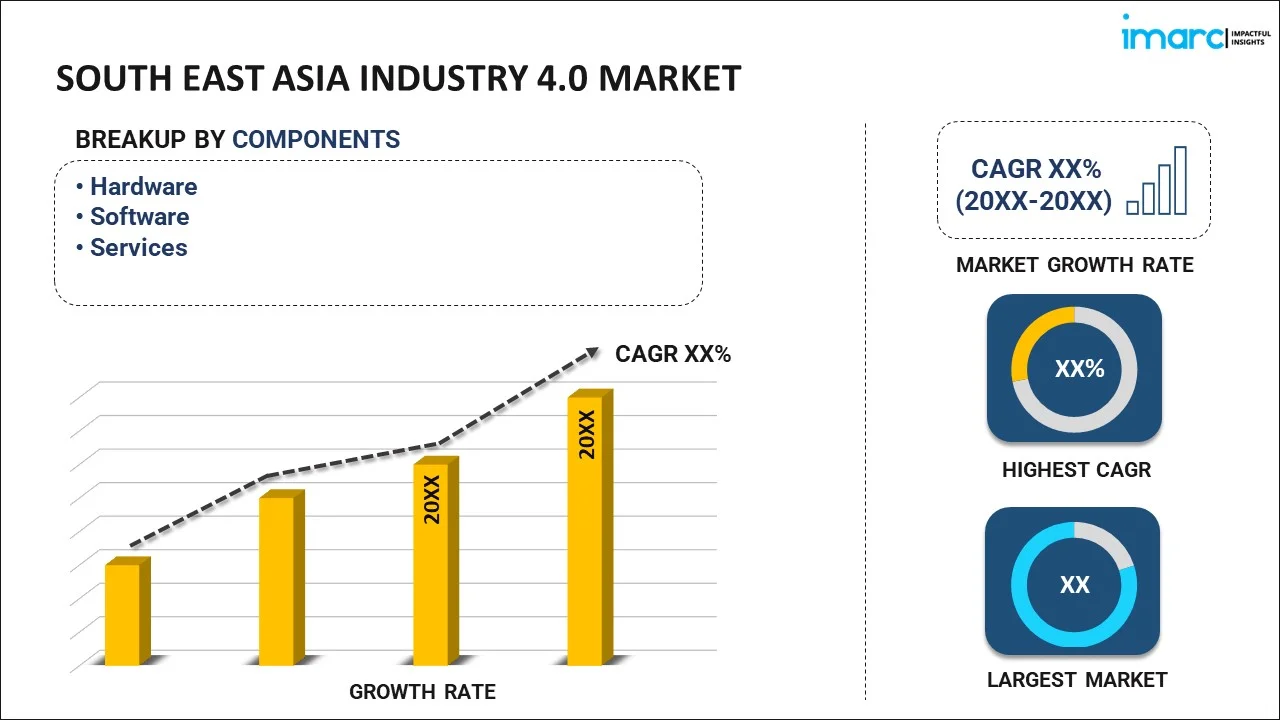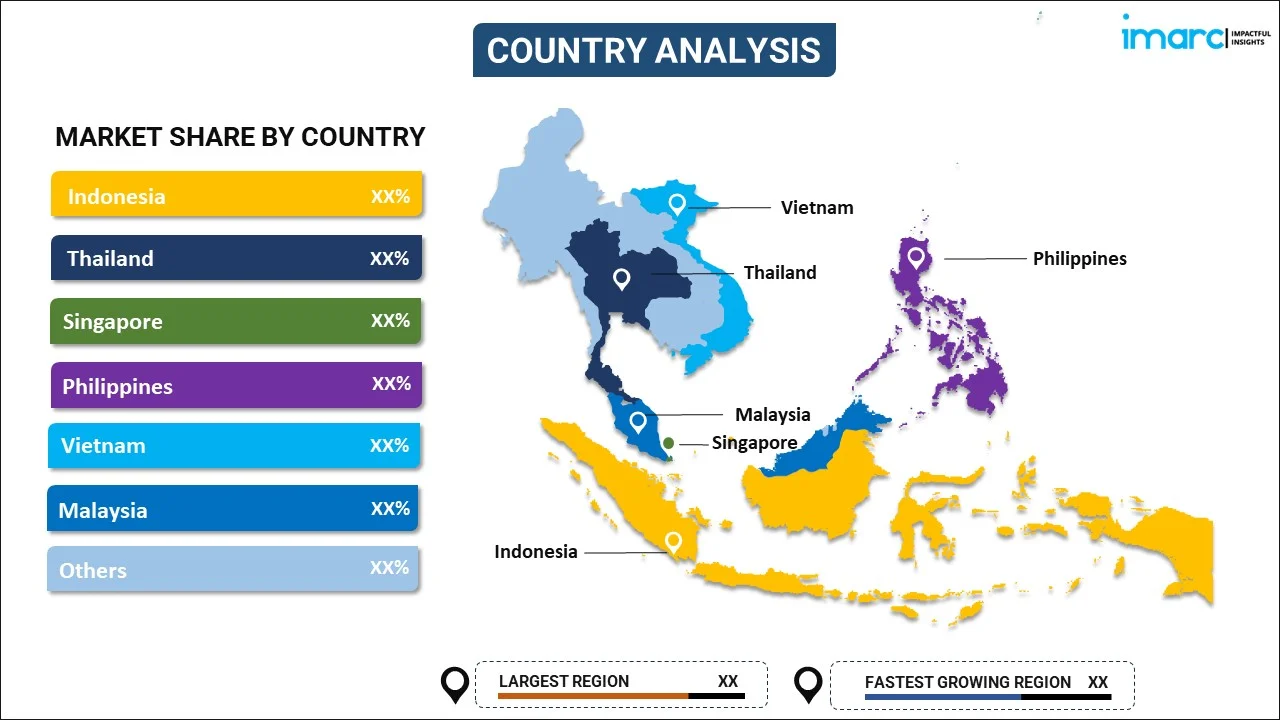
South East Asia Industry 4.0 Market Report by Component (Hardware, Software, Services), Technology Type (Industrial Robotics, Industrial IoT, AI and ML, Blockchain, Extended Reality, Digital Twin, 3D Printing, and Others), End Use Industry (Manufacturing, Automotive, Oil and Gas, Energy and Utilities, Electronic and Foundry, Food and Beverages, Aerospace and Defense, and Others), and Country 2024-2032
Market Overview:
South East Asia industry market size is projected to exhibit a growth rate (CAGR) of 21.90% during 2024-2032. The growing demand for automation, predictive maintenance, and real-time monitoring of assets and processes, rising utilization of advanced tools to manage complexities of supply chains, and increasing need to reduce carbon footprints represent some of the key factors driving the market.
|
Report Attribute
|
Key Statistics
|
|---|---|
|
Base Year
|
2023 |
|
Forecast Years
|
2024-2032
|
|
Historical Years
|
2018-2023
|
| Market Growth Rate (2024-2032) | 21.90% |
Industry 4.0 refers to the integration of digital technologies, automation, and data exchange across various sectors. It allows companies to monitor equipment in real time, identifying and addressing issues before they lead to costly breakdowns using Internet of Things (IoT) devices and sensors. It also enables organizations to lower their operational costs with better resource allocation, optimized supply chains, and reduced waste while minimizing the need for manual labor, saving on labor expenses over time. It can detect even minor deviations in production processes and make real-time adjustments, ensuring that every product meets high-quality standards. It helps in gaining insights into consumer preferences, market trends, and production processes to make informed decisions, leading to better outcomes. It assists companies in tailoring their offerings to meet individual needs and enhance user satisfaction and brand loyalty. It also aids in optimizing inventory management, reducing lead times, and responding quickly to changes in demand, ultimately resulting in a more agile and responsive supply chain. As it promotes sustainability by minimizing resource wastage and energy consumption while reducing the ecological footprint of industries, the demand for Industry 4.0 is rising in the South East Asia region.
South East Asia Industry 4.0 Market Trends:
At present, advancements in technology, including the Internet of Things (IoT), artificial intelligence (AI), big data analytics, and robotics represent one of the key factors supporting the growth of the market in South East Asia. These technologies enable the seamless integration of physical and digital systems, enhancing efficiency and productivity across various industries. Besides this, companies are increasingly adopting Industry 4.0 solutions to reduce operational costs. Automation, predictive maintenance, and real-time monitoring of assets and processes help minimize downtime, optimize resource utilization, and lower overall production costs. Moreover, rapid globalization is leading to more complex supply chains. Industry 4.0 provides the tools to manage this complexity effectively, with real-time data sharing while enabling companies to respond swiftly to changes in demand and supply in the region. In line with this, Industry 4.0 technologies enable businesses to tailor their offerings as per individual consumer preferences, creating a competitive advantage. In addition, the growing environmental concerns, and the need to reduce carbon footprints are encouraging industries to adopt more sustainable practices. Industry 4.0 facilitates resource optimization and waste reduction, aligning with sustainability goals. Apart from this, governing agencies in the South East Asia region are recognizing the potential benefits of Industry 4.0. They are implementing policies and regulations to incentivize and support the adoption of these technologies, further propelling the growth of the market in the region.
South East Asia Industry 4.0 Market Segmentation:
IMARC Group provides an analysis of the key trends in each segment of the market, along with forecasts at the regional and country levels for 2024-2032. Our report has categorized the market based on component, technology type, and end use industry.
Component Insights:

- Hardware
- Software
- Services
The report has provided a detailed breakup and analysis of the market based on the component. This includes hardware, software, and services.
Technology Type Insights:
- Industrial Robotics
- Industrial IoT
- AI and ML
- Blockchain
- Extended Reality
- Digital Twin
- 3D Printing
- Others
A detailed breakup and analysis of the market based on the technology type have also been provided in the report. This includes industrial robotics, industrial IoT, AI and ML, blockchain, extended reality, digital twin, 3D printing, and others.
End Use Industry Insights:
- Manufacturing
- Automotive
- Oil and Gas
- Energy and Utilities
- Electronic and Foundry
- Food and Beverages
- Aerospace and Defense
- Others
The report has provided a detailed breakup and analysis of the market based on the end use industry. This includes manufacturing, automotive, oil and gas, energy and utilities, electronic and foundry, food and beverages, aerospace and defense, and others.
Country Insights:

- Indonesia
- Thailand
- Singapore
- Philippines
- Vietnam
- Malaysia
- Others
The report has also provided a comprehensive analysis of all the major regional markets, which include Indonesia, Thailand, Singapore, Philippines, Vietnam, Malaysia, and Others.
Competitive Landscape:
The market research report has also provided a comprehensive analysis of the competitive landscape in the market. Competitive analysis such as market structure, key player positioning, top winning strategies, competitive dashboard, and company evaluation quadrant has been covered in the report. Also, detailed profiles of all major companies have been provided.
South East Asia Industry 4.0 Market Report Coverage:
| Report Features | Details |
|---|---|
| Base Year of the Analysis | 2023 |
| Historical Period | 2018-2023 |
| Forecast Period | 2024-2032 |
| Units | US$ Million |
| Scope of the Report | Exploration of Historical and Forecast Trends, Industry Catalysts and Challenges, Segment-Wise Historical and Predictive Market Assessment:
|
| Components Covered | Hardware, Software, Services |
| Technology Types Covered | Industrial Robotics, Industrial IoT, AI and ML, Blockchain, Extended Reality, Digital Twin, 3D Printing, Others |
| End Use Industries Covered | Manufacturing, Automotive, Oil and Gas, Energy and Utilities, Electronic and Foundry, Food and Beverages, Aerospace and Defense, Others |
| Countries Covered | Indonesia, Thailand, Singapore, Philippines, Vietnam, Malaysia, Others |
| Customization Scope | 10% Free Customization |
| Report Price and Purchase Option | Single User License: US$ 3699 Five User License: US$ 4699 Corporate License: US$ 5699 |
| Post-Sale Analyst Support | 10-12 Weeks |
| Delivery Format | PDF and Excel through Email (We can also provide the editable version of the report in PPT/Word format on special request) |
Key Questions Answered in This Report:
- How has the South East Asia industry 4.0 market performed so far and how will it perform in the coming years?
- What has been the impact of COVID-19 on the South East Asia industry 4.0 market?
- What is the breakup of the South East Asia industry 4.0 market on the basis of component?
- What is the breakup of the South East Asia industry 4.0 market on the basis of technology type?
- What is the breakup of the South East Asia industry 4.0 market on the basis of end use industry?
- What are the various stages in the value chain of the South East Asia industry 4.0 market?
- What are the key driving factors and challenges in the South East Asia industry 4.0?
- What is the structure of the South East Asia industry 4.0 market and who are the key players?
- What is the degree of competition in the South East Asia industry 4.0 market?
Key Benefits for Stakeholders:
- IMARC’s industry report offers a comprehensive quantitative analysis of various market segments, historical and current market trends, market forecasts, and dynamics of the South East Asia industry 4.0 market from 2018-2032.
- The research report provides the latest information on the market drivers, challenges, and opportunities in the South East Asia industry 4.0 market.
- Porter's five forces analysis assist stakeholders in assessing the impact of new entrants, competitive rivalry, supplier power, buyer power, and the threat of substitution. It helps stakeholders to analyze the level of competition within the South East Asia industry 4.0 industry and its attractiveness.
- Competitive landscape allows stakeholders to understand their competitive environment and provides an insight into the current positions of key players in the market.
Need more help?
- Speak to our experienced analysts for insights on the current market scenarios.
- Include additional segments and countries to customize the report as per your requirement.
- Gain an unparalleled competitive advantage in your domain by understanding how to utilize the report and positively impacting your operations and revenue.
- For further assistance, please connect with our analysts.
 Inquire Before Buying
Inquire Before Buying
 Speak to an Analyst
Speak to an Analyst
 Request Brochure
Request Brochure
 Request Customization
Request Customization




.webp)




.webp)












